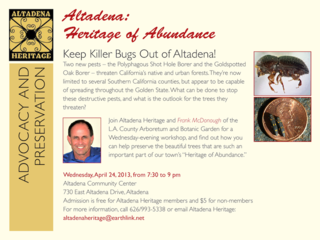Nancy Romero lives in a 1909 Craftsman farmhouse and -- up until late 2012 -- she had a row of boxelders that were the same vintage.
But now she's gone from a shady garden to a sunny garden, and not by choice.
Romero called an arborist when the trees were showing obvious signs of distress. The arborist said they had to be cut down -- and not just cut down, but ground up, contain the dust, and make sure the sawdust never goes into any greenwaste for composting.
The reason? Her trees fell victim to an invading pest, the Polyphagous Shot Hole Borer. The beetle, named Euwallacea fornicatus, just to let you know what scientists think of it, digs small holes into trees to move in. The females carry a fungus with them, that infests the tree, and the beetle and its larvae live off of it.
First detected in California in 2003, the beetle is believed to have come from Asia or Africa. It bores "galleries" in trees where the water flows from roots to leaves, grows the fungus in them, and that's where the larvae feed. Brothers mate with sisters, and a mated female begins to dig her own galleries and plant her own fungus farm.
Romero said that it only took a matter of months before her trees began to die.
The problem is widespread around California, as E. fornicatus can attack almost any native or fruit tree. The total destruction of an infected tree is currently the best way to stop them.
Altadena Heritage is holding a workshop on Wednesday, April 24, with Frank McDonough of the LA County Arboretum and Botanic Garden to look at E. fornicatus and another tree-killing invader, the Goldspotted Oak Borer. McDonough will talk about the effects of the invasion, and possible ways to destroy the pests.
The meeting is at the Altadena Community Center, 730 E. Altadena Dr., from 7:30-9 PM. Admission is free for members, and $5 for non-members. Click on the graphic for more information.




